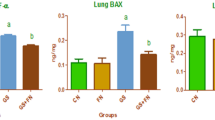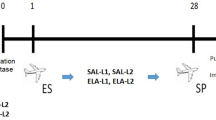Abstract
Stachybotrys chartarum is an important toxigenic fungus often associated with chronically wet cellulose-based building materials. The purpose of this study was to evaluate some histological, immunohistochemical and morphometric changes in mouse lung tissues exposed intratracheally to either 50 μl of 1.4 × 106 S. chartarum spores (≤35 ng toxin/kg BW), isosatratoxin-F (35ng/kg BW),50 μl of 1.4 × 106 Cladosporium cladosporioides spores, or 50 μl saline. Exposure of lung tissues to S. chartarum or C. cladosporioides spores resulted in granuloma formation at the sites of spore impaction. Some of the lung tissues impacted by S. chartarum spores also showed erythrocyte accumulation in the alveolar air space, dilated capillaries engorged with erythrocytes, and hemosiderin accumulation at spore impaction sites, which were features not noted in the C. cladosporioides-spore treated animals. Immunohistochemistry revealed reduced collagen IV distribution in lung granulomas in S. chartarum-treated animals especially at 48 and 72 hr post-exposure compared to that in lungs of mice with C. cladosporioides-spore induced granulomas. Quantitative analysis of pooled S. chartarum and C. cladosporioides spore impacted lungs revealed significant depression (P < 0.05) of alveolar air space from 71.4 ± 6.1 in untreated animals to 56.04 ± 6.1 in the S. chartarum- and 60.24 ± 5.5% in the C. cladosporioides-spore treated animals. It also revealed that alveolus air space in S. chartarum treated animals declined significantly from 63.74 ± 3.1% at12 hr post-exposure to 42.94 ± 7.9% at 72 hr post-exposure and was increased to 54.84 ± 5.2% at 96 hr post-exposure. Alveolus air space in C. cladosporioidestreated animals also decreased significantly from 64.84 ± 7.1% at 12 hr exposure to 54.94 ± 5.4% at 48 hr post-exposure and was increased to 64.64 ± 10.1% at 96 hr post-exposure. It also revealed significant (P <0.05) alveolar accumulation of erythrocytes from 1.24 ± 1.4% in the untreated animals to 3.44 ± 1.5% in the pooled S. chartarum spore treated animals. Erythrocyte abundance in S. chartarum treated animals increased significantly (P <0.001) from 2.14 ± 1. 7% at 12 hr post-exposure to 5.54 ± 1.5% at 72 hr and 4.94 ± 1.4% at 96 hr post-exposure. These results further reveal that exposure to S. chartarum spores elicit tissue responses in vivo significantly different from those associated with exposure to pure trichothecene toxin and to spores of a non-toxigenic fungus.
Similar content being viewed by others
References
Antonini JM, Hemeenway DR, Davis DS. Quantitative image analysis of lung connective tissue in murine silicosis. Experimental Lung Res 2000; 26: 71–88.
Bozzola JJ, Russell LD. Electron Microscopy. Boston: Jones and Bartlett Publishers, 1992
Burkitt HG, Young B, Heath JW. Wheater's Functional Histology — A Text and Color Atlas (3rd ed.), New York: Churchill—Livingstone, 1993.
CCAC. Guide to the care and use of experimental animals. Volume 1. Ottawa: Bradda Printing Services Inc., Ottawa, 1993.
Creasia DA, Thurman JD, Jones LJ, Neally ML, York CG, Wannamacher RW, Bunner DL. Acute Inhalation toxicity of 130 T—2 Mycotoxin in mice. Fundam Appl Toxicol 1987; 8: 230–235.
Creasia DA, Thurman JD, Wannamacher RW, Bunner DL Acute Inhalation toxicity of T—2 Mycotoxin in the rat and guinea pig. Fundam Appl Toxicol 1987; 14: 54–59.
Croft WA, Jarvis BB, Yatawara SC. Airborne outbreak of trichothecene toxicosis. Atmos Environ 1986; 20: 549–552.
Davies P. Quantitative morphology of the lung. A practical Manual. Harvard Medical School Publication. Boston, 1980.
Day JH. Allergic respiratory responses to fungi. In: Esser K, Lempke PA, eds. The Mycota. Vol. VII. Animal and Human Relationships. Springer Verlag, Berlin, 1996.
Dearborn DG, Yike I, Sorenson WG, Miller MJ, Etzel RA. Overview of investigations into pulmonary hemorrhage among infants in Cleveland, Ohio. Environ Health Persp 1999; 107: 495–499.
Emanual DA, Wenzel FJ, Lawton BR. Pulmonary mycotoxicosis. Chest. 1975; 67: 293–297.
Etzel RA, Dearborn DG. Pulmonary hemorrhage among infants with exposure to toxigenic molds: an overview. In: Johanning E, ed. Bioaerosols, Fungi and Mycotoxins: Health effects, asessment, pevention and control. Eastern New York Occupational and Environmental Health Center, Albany, New York, 1999; 79–83.
Etzel RA, Montana E, Sorenson WG, Kullman GJ, Allan TM, Dearborn DG. Acute pulmonary hemorrhage in infants associated with exposure to Stachybotrys atra and other fungi. Arch Pediatr Adolesc Med 1998; 152: 757–762.
Happerfield LC. Assessment of oestrogen and progesterone receptor antibodies in formalin—fixed routinely processed paraffin—wax embedded tissue. J Cell Path 1996; 1: 170–178.
Hintikka E—L. The effect of inhaled spores of mycotoxin producing fungi on animals. In: Johanning E, ed. Bioaerosols, fungi and mycotoxins: Health effects, assessment, prevention and control. Eastern New York Occupational and Environmental Health Center, Albany, New York, 1999; 214–220.
Hodgson MJ, Morey P, Leung W—Y, Morrow L, Miller JD, Jarvis BB, Robbins H, Halsey JF, Storey E. Building—associated pulmonary disease from exposure to Stachybotrys chartarum and Aspergillus versicolor. J Occup Environ Med 1998; 40: 241–249.
Hoff GL, Frye FL, Jacobson ER. eds. Diseases of amphibians and reptiles. New York: Plenum Press, 1984.
Humason GL. Animal Tissue Techniques. San Francisco: W.H. Freeman and Co., 1976.
Jarvis BB, Hinkley SF. Analysis of Stachybotrys toxins. In: Johanning E, ed. Bioaerosols, Fungi and mycotoxins: Health effects, assessment, prevention and control. New York: Albany, Eastern New York Occupational and Environmental Health Center, 1999; 232–239.
Johanning E. Health problems related to fungal exposure: the example of toxigenic Stachybotrys chartarum (atra). In: Johanning E, ed. Bioaerosols, fungi and mycotoxins: Health effects, assessment, prevention and control. Eastern New York Occupational and Environmental Health Center, New York: Albany, 1995.
Johanning E, Biagini R, Hull D, Morey P, Jarvis B. Landsbergis P. Health and immunology study following exposure to toxigenic fungi (Stachybotrys chartarum) in a Water—Damaged Office Environment. Int Arch Occup Environ Health 1996; 68: 207–218.
Johanning E, Landsbergis P, Gareis M, Yang C, Olmsted E. Clinical experience and results of a sentinel health investigation related to indoor fungal exposure. Environ Heath Perspectives 1999; 107: 489–494.
Kordula T, Banbula A, Macomson J, Travis J. Isolation and properties of Stachyrase A, a chymotrypsin—like serine proteinase from Stachybotrys chartarum. Infection and Immunity 2002; 419–421.
Lopez A, Albassam M, Yong S, Sharma A, Lillie LE, Prior MG. Profiles of type—II pneumocytes in rats inoculated intratracheally with bacterial lipopolysaccharide. American Journal of Veterinary Research 1987; 48: 1534–1539.
MaCrae KC, Rand TG, Shaw R.A, Mason C, Oulton MR, Hastings C, Cherlet T, Thliveris JA, Mantsch HH, MacDonald J, Scott JE. Analysis of pulmonary surfactant by Fouriertransform infrared spectroscopy following exposure to Stachybotrys chartarum (atra) spores. Chemistry and Physics of Lipids. 2001; 110: 1–10.
Marrs TC, Edginton JAG, Price PN, Upshall DG. Acute toxicity of T2 mycotoxin to the guinea pig by inhalation andsubcutaneous routes. Br J Exp Path 1986; 67: 259–268.
Mason CD, Rand TG, Oulton M, MacDonald JM, Scott JE. Effects of Stachybotrys chartarum (atra) Conidia and isolated toxin on lung surfactant production and homeostasis. Natural Toxins 1998; 6: 27–33.
Mason CD, Rand TG, Oulton M, MacDonald J. The effect of Stachybotrys chartarum spores and an isolated trichothecene, isosatratoxin F, on convertase activity in mice. Toxicology and Applied Pharmacology. 2001; 172: 21–28.
Nikulin M, Reijula K, Jarvis BB, Hintikka E.—L. Experimental lung mycotoxicosis in mice induced by Stachybotrys atra. Int J Exp Path 1996; 77: 213–218.
Nikulin M, Reijula K, Jarvis B, Veijalainen P, Hintikka E—L Effects of intranasal exposure to Stachybotrys atra. Fundam Appl Toxicol 1997; 35: 182–188.
Pang VF, Lambert RJ, Felsberg PJ, Beasley VR, Buck WB, Haschek WM. Experimental T—2 toxicosis in swine following inhalation exposure: clinical sign and effects on haematology, serum biochemistry, and immune response. Fundam and Applied Toxicol. 1998; 11: 100–109.
Rand TG, Bunkley—Williams L, Williams EH. A systemic mycosis of two species of tilapia (Tilapia mossambica and T. aura) caused by Paecilomyces lilacinus from Puerto Rico. J Aquatic Animal Health 2000; 12: 149–156.
Rao CY, Brain JD, Burge HA. Reduction of pulmonary toxicity of Stachybotrys chartarum spores by methanol extraction of mycotoxins. Appl Environ Microbiol 2000a; 66: 2817–2821.
Rao CY, Burge HA, Brain JD. The time course of responses to intratracheally instilled toxic Stachybotrys chartarum spores in rats. Mycopathologia 2000b; 149: 27–34.
Rhoades R, Pflanzer R. Human Physiology. Toronto: Saunders College Publishing, 1996.
Riley RT, Norred WP. Mechanisms of Mycotoxicity. In: Howard H, Miller JD, eds, The Mycota, vol. VI. New York: Springer—Verlag, 1996.
Robbins S L, Angell M. Basic pathology. Toronto: W.B. Saunders Company, 1976.
Sumarah MW, Rand TG, Mason CD, Oulton M, MacDonald J, Anthes M. Effects of Stachybotrys chartarum Spores and Toxin on Mouse Lung/Surfactant Phospholipid Composition. In: Johanning E, ed. Bioaerosols, fungi and mycotoxins: Health effects, assessment, prevention and control. Eastern New York Occupational and Environmental Health Center, Albany, New York, 1999; 444–452.
Sumi Y, Hamasaki T, Miyakawa M. Tumors and other lesions in germ—free rats exosed to Aspergillus versicolor alone. Jpn J Cancer Research 1987; 78: 480–486.
Sumi Y, Nagura H, Takeuchi M, Miyakawa M. Granulomatous lesions in the lung induced by inhalation of mold spores. Vichows Arch 1994; 424: 661–668.
Thurman JD, Creasia DA, Trotter RW. Mycotoxicosis caused by aerosolised T—2 toxin administered to female mice. Am J Vet Res 1988; 49: 1928–1931.
Yike I, Rand T, Dearborn D. Proteases from the spores of toxigenic fungus Stachybotrys chartarum. Amer. Thoracic Society Meeting. Atlanta, 2002.
Yike I, Miller MJ, Tomashefski J, Walenga R, Dearborn D. Infant rat model of Stachybotrys chartarum induced mycotoxicosis. Mycopathologia (in press) 2002.
Vesper SJ, Dearborn DG, Elidemir O, Haugland RA. Quantification of siderophore and hemolysin from Stachybotrys chartarum strains including a strain isolated from the lung of a child with pulmonary hemorrhage and haemosiderosis. Applied and Environ Microbiology 2000; 66(6): 2678–2681.
Vesper SJ, Magnuson J, Dearborn DG, Yike I, Haugland RA. Initial characterization of the hemolysin stachylysin from Stachybotrys chartarum. Infect Immun 2001; 69: 912–916.
Wild CP, Hall AJ. Epidemiology of mycotoxin—related disease. In Howard H, Miller JD, eds. The Mycota, vol. VI. New York: Springer—Verlag. 1996: 213–227.
Author information
Authors and Affiliations
Rights and permissions
About this article
Cite this article
Rand, T., White, K., Logan, A. et al. Histological, immunohistochemical and morphometric changes in lung tissue in juvenile mice experimentally exposed to Stachybotrys chartarum spores. Mycopathologia 156, 119–131 (2003). https://doi.org/10.1023/A:1022920205355
Issue Date:
DOI: https://doi.org/10.1023/A:1022920205355




